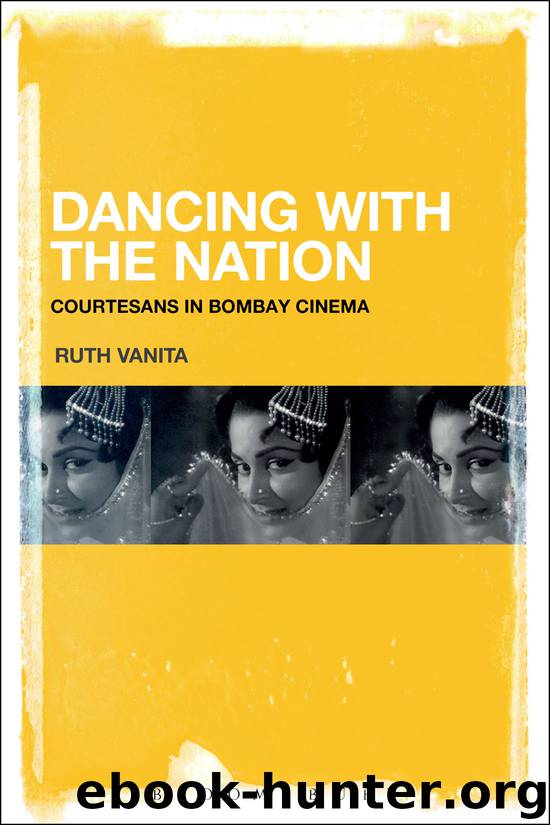Dancing with the Nation by Ruth Vanita

Author:Ruth Vanita
Language: eng
Format: epub
Publisher: Bloomsbury USA
Career and Fame
Unlike female manual labourers, glorified in films like Mother India (1957) and Trishul [Trident] (1978), courtesans have careers, not just jobs. Mirza Ghalib (1954) depicts the development of a career. Singer Moti Begum’s mother is in debt and agrees to marry her to a police officer who offers money for her. But once Moti dances at court and pleases the Mughal emperor, she is rewarded, becomes well known, and is invited to perform in upper-class homes. This mirrors the upward mobility available to poor but talented performers in precolonial cities.
Courtesans were among the few women who acquired fame through their work. But courtesan characters rarely acknowledge enjoying the acclaim they receive.
Shair (1949) is unusual, featuring one of the least didactic depictions of a dancer. The cleverly named Meena Kumari advertises her attractions in ways that anticipate the internet era. She corresponds with potential clients and sends them autographed photos of herself. Without having met her, one of them, a rich businessman, comes to Bombay to stay with her. Nearly four decades later, another Meena, in Sharabi [Drunkard] (1984), also a dancer, employs an agent who shows photographs of her to a potential patron. Both seem quite happy with their careers.
A few stage dancers and actresses are shown as proud of their performances and eager for applause. In Teesri Kasam (1966), when nautanki dancer Heerabai’s admirer Heeraman asks her to change her profession, she responds, ‘Nasha ho gaya (I am addicted). Just as you are addicted to driving your bullock cart I am addicted to acting Laila and Gulbadan [romantic heroines].’ She stands facing him, her dressing table with cosmetic items between them, symbolizing her vocation that divides them. ‘Travelling from place to place, adorning myself to sing and dance under the bright lights, what else do I have in life apart from this intoxication?’
Guide (1965) explores female ambition at some length. Rosie, daughter of a devadasi, says she wants to make a name for herself, but her mother forces her into marriage. In a plot line that was radical for its time, the film has her leave her husband and embrace dancing, a profession that he and most people in her lover’s village despise. Her lover, however, declares that she belongs to the exalted community of artists (see chapters 4 and 5). But her fame and wealth is shown damaging their relationship.
Two films in the 1970s explore the fissures that a dancing career creates between husband and wife. In Abhinetri [Actress] (1970), courtesan-like dancer Anjana’s husband berates her for enjoying compliments and bouquets from male admirers; she retorts that he is jealous of her fame. He implicitly lumps Anjana with a cabaret dancer they see at a restaurant, saying, ‘People like you should go live in the West. You don’t understand our culture. … You think displaying your bodies on stage is art.’
Later, Shekhar’s mother, who had herself given up singing after marriage, takes an ambiguous stance when she asks Anjana to dance, and says dancing at home
Download
This site does not store any files on its server. We only index and link to content provided by other sites. Please contact the content providers to delete copyright contents if any and email us, we'll remove relevant links or contents immediately.
Shoot Sexy by Ryan Armbrust(17162)
Portrait Mastery in Black & White: Learn the Signature Style of a Legendary Photographer by Tim Kelly(16498)
Adobe Camera Raw For Digital Photographers Only by Rob Sheppard(16410)
Photographically Speaking: A Deeper Look at Creating Stronger Images (Eva Spring's Library) by David duChemin(16174)
Bombshells: Glamour Girls of a Lifetime by Sullivan Steve(13137)
Art Nude Photography Explained: How to Photograph and Understand Great Art Nude Images by Simon Walden(12376)
Perfect Rhythm by Jae(4641)
Pillow Thoughts by Courtney Peppernell(3446)
The Book of Joy by Dalai Lama(3257)
Good by S. Walden(2930)
The Pixar Touch by David A. Price(2753)
Fantastic Beasts: The Crimes of Grindelwald by J. K. Rowling(2558)
A Dictionary of Sociology by Unknown(2527)
Humans of New York by Brandon Stanton(2387)
Read This If You Want to Take Great Photographs by Carroll Henry(2314)
Stacked Decks by The Rotenberg Collection(2295)
On Photography by Susan Sontag(2146)
Photographic Guide to the Birds of Indonesia by Strange Morten;(2100)
Insomniac City by Bill Hayes(2094)
